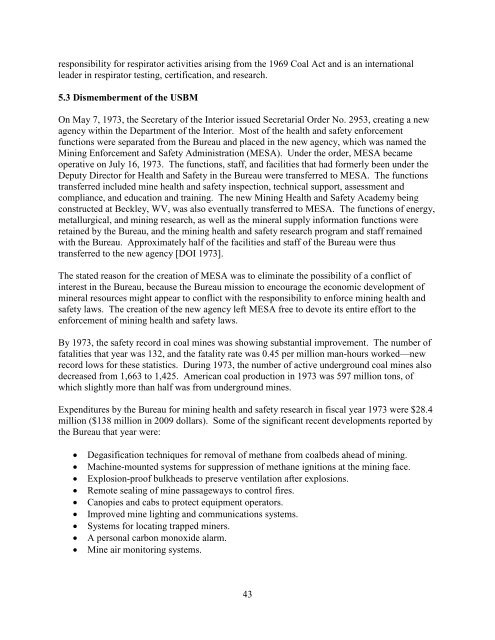One Hundred Years of Federal Mining Safety and Health Research
One Hundred Years of Federal Mining Safety and Health Research
One Hundred Years of Federal Mining Safety and Health Research
- No tags were found...
You also want an ePaper? Increase the reach of your titles
YUMPU automatically turns print PDFs into web optimized ePapers that Google loves.
esponsibility for respirator activities arising from the 1969 Coal Act <strong>and</strong> is an international<br />
leader in respirator testing, certification, <strong>and</strong> research.<br />
5.3 Dismemberment <strong>of</strong> the USBM<br />
On May 7, 1973, the Secretary <strong>of</strong> the Interior issued Secretarial Order No. 2953, creating a new<br />
agency within the Department <strong>of</strong> the Interior. Most <strong>of</strong> the health <strong>and</strong> safety enforcement<br />
functions were separated from the Bureau <strong>and</strong> placed in the new agency, which was named the<br />
<strong>Mining</strong> Enforcement <strong>and</strong> <strong>Safety</strong> Administration (MESA). Under the order, MESA became<br />
operative on July 16, 1973. The functions, staff, <strong>and</strong> facilities that had formerly been under the<br />
Deputy Director for <strong>Health</strong> <strong>and</strong> <strong>Safety</strong> in the Bureau were transferred to MESA. The functions<br />
transferred included mine health <strong>and</strong> safety inspection, technical support, assessment <strong>and</strong><br />
compliance, <strong>and</strong> education <strong>and</strong> training. The new <strong>Mining</strong> <strong>Health</strong> <strong>and</strong> <strong>Safety</strong> Academy being<br />
constructed at Beckley, WV, was also eventually transferred to MESA. The functions <strong>of</strong> energy,<br />
metallurgical, <strong>and</strong> mining research, as well as the mineral supply information functions were<br />
retained by the Bureau, <strong>and</strong> the mining health <strong>and</strong> safety research program <strong>and</strong> staff remained<br />
with the Bureau. Approximately half <strong>of</strong> the facilities <strong>and</strong> staff <strong>of</strong> the Bureau were thus<br />
transferred to the new agency [DOI 1973].<br />
The stated reason for the creation <strong>of</strong> MESA was to eliminate the possibility <strong>of</strong> a conflict <strong>of</strong><br />
interest in the Bureau, because the Bureau mission to encourage the economic development <strong>of</strong><br />
mineral resources might appear to conflict with the responsibility to enforce mining health <strong>and</strong><br />
safety laws. The creation <strong>of</strong> the new agency left MESA free to devote its entire effort to the<br />
enforcement <strong>of</strong> mining health <strong>and</strong> safety laws.<br />
By 1973, the safety record in coal mines was showing substantial improvement. The number <strong>of</strong><br />
fatalities that year was 132, <strong>and</strong> the fatality rate was 0.45 per million man-hours worked—new<br />
record lows for these statistics. During 1973, the number <strong>of</strong> active underground coal mines also<br />
decreased from 1,663 to 1,425. American coal production in 1973 was 597 million tons, <strong>of</strong><br />
which slightly more than half was from underground mines.<br />
Expenditures by the Bureau for mining health <strong>and</strong> safety research in fiscal year 1973 were $28.4<br />
million ($138 million in 2009 dollars). Some <strong>of</strong> the significant recent developments reported by<br />
the Bureau that year were:<br />
• Degasification techniques for removal <strong>of</strong> methane from coalbeds ahead <strong>of</strong> mining.<br />
• Machine-mounted systems for suppression <strong>of</strong> methane ignitions at the mining face.<br />
• Explosion-pro<strong>of</strong> bulkheads to preserve ventilation after explosions.<br />
• Remote sealing <strong>of</strong> mine passageways to control fires.<br />
• Canopies <strong>and</strong> cabs to protect equipment operators.<br />
• Improved mine lighting <strong>and</strong> communications systems.<br />
• Systems for locating trapped miners.<br />
• A personal carbon monoxide alarm.<br />
• Mine air monitoring systems.<br />
43
















